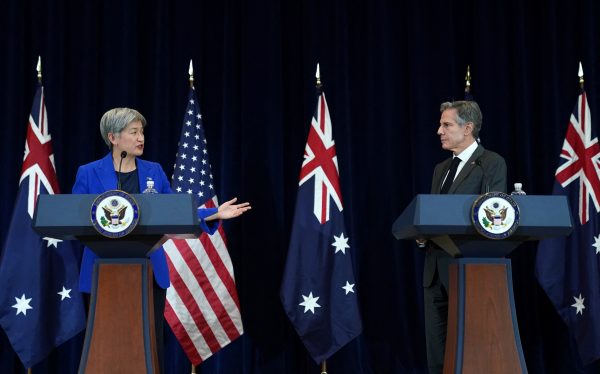The AUSMIN consultations, which occurred in December 2022, led defence commentators to focus on the expanding military cooperation between the United States and Australia. But this commentary misses the emphasis placed on ‘urgent action on climate change’ and the ‘clean energy transition’ in the final joint statement.
The decision to include a climate pillar in the US–Australia alliance makes perfect sense from the standpoint of both parties in terms of individual and regional security. The election of Australian Prime Minister Anthony Albanese’s centre-left Labor Party government brought with it a more ambitious 2030 mitigation target in line with international obligations. This aligns with the Biden administration’s decarbonisation policy, symbolically launched the very day US President Biden was sworn in by rejoining the Paris Agreement.
Australia’s decision to emphasise climate change during AUSMIN speaks to the Albanese government’s desire to project Canberra as a reliable partner after decades of half-hearted climate commitments. This revamp of Australia’s image has enabled Canberra to score points with its neighbours. Pacific island nations consider climate change to be an existential threat and have long called for Australia to reduce its emissions and transition to clean energy. Canberra is also vying to maximise its influence in Southeast Asia, another region vulnerable to the effects of climate change.
Australia and the United States play complementary roles in the development of green technologies. Australia is the world’s largest lithium supplier, a mineral that is essential for the fabrication of electric vehicles and storage batteries. Australia is also well-positioned to become a global leader in the production of green and blue hydrogen.
The United States is competing to achieve leadership in green technologies. It is ranked second worldwide for renewable energy capacity and has recently introduced the Inflation Reduction Act, which incentivises green technology investment through the provision of large subsidies.
To expand its markets for green energy, the United States could look to Australia. The combination of US technology and Australia’s ability to harness solar and wind energy and provide critical materials would allow both the nations themselves and their regional partners to diversify their energy sources.
The AUSMIN 2022 joint statement may provide a new blueprint for security cooperation. While the United States and Australia have previously offered humanitarian and disaster response assistance to developing countries, particularly in the Pacific, the climate pillar strikes a different tone by focussing on ‘climate mitigation, adaptation, and resilience efforts’.
As Foreign Minister Wong said in a speech to the Carnegie Endowment for International Peace, Australia is ‘bringing more to the table’ for Pacific island states. The precedent set by AUSMIN 2022 is likely to be echoed in the Papua New Guinea–Australia Bilateral Security Treaty, set to be signed in 2023.
Foreign Minister Wong’s metaphor sets support for the Pacific against the backdrop of great power competition, where Australia is seen as countering Chinese influence in the region on behalf of the United States. China has addressed the issue of climate change in its Global Security Initiative and bilateral security agreements. But these efforts have been focused — just as the United States’ efforts were until AUSMIN 2022 — on ‘maintaining security in non-traditional security domains’ and sending personnel for ‘humanitarian assistance’ and ‘disaster response’. China’s conception of security, while broad and all-encompassing, does not specify climate mitigation.
Australia is well-positioned to appeal as a partner to the Pacific region. By bringing ‘more’ to the table in the form of proactive climate support, Australia is ensuring that the United States remains engaged in the Pacific.
The inclusion of a climate pillar in the United States–Australia alliance does raise questions of dependency within the alliance. Just as the debate over AUKUS has raised fears in Australia of lost sovereignty, the climate pillar of the United States–Australia alliance risks reducing Canberra to a subordinate role. Through the Inflation Reduction Act the United States is putting in place an architecture to attract investment in green technologies on its soil, which has inevitably raised fears in the European Union and South Korea that companies may divert investment to the United States.
Canberra is well-placed to become a leader in renewable energy but will need enormous investment to develop the technology needed to achieve its aspirations. While the alliance could serve as a venue to discuss these issues, the institutionalisation of dialogue may not be sufficient to prevent Washington from going it alone.
Given that the bulk of green technologies will likely be developed and rolled out in the United States, Australia risks becoming a mere supplier of materials. Australia risks falling behind in the development of high-skilled and less carbon-intensive jobs as a result.
Coordination on climate change is strategically significant for both Canberra and Washington. But coordination with Washington is difficult. Only careful alliance management on Canberra’s part can help Australia avoid being pushed aside.
Walter Colnaghi completed a Master of Science at the London School of Economics and has experience working for the Italian Foreign Ministry and the European External Action Service in the Indo-Pacific.
Jackson Skinner is an international security student at The Australian National University and an editorial staff member at East Asia Forum.

